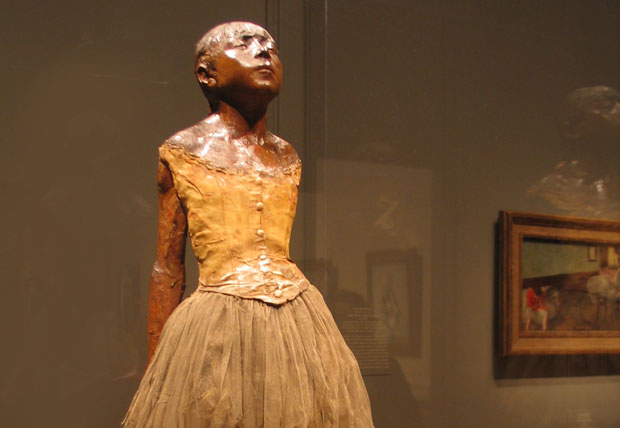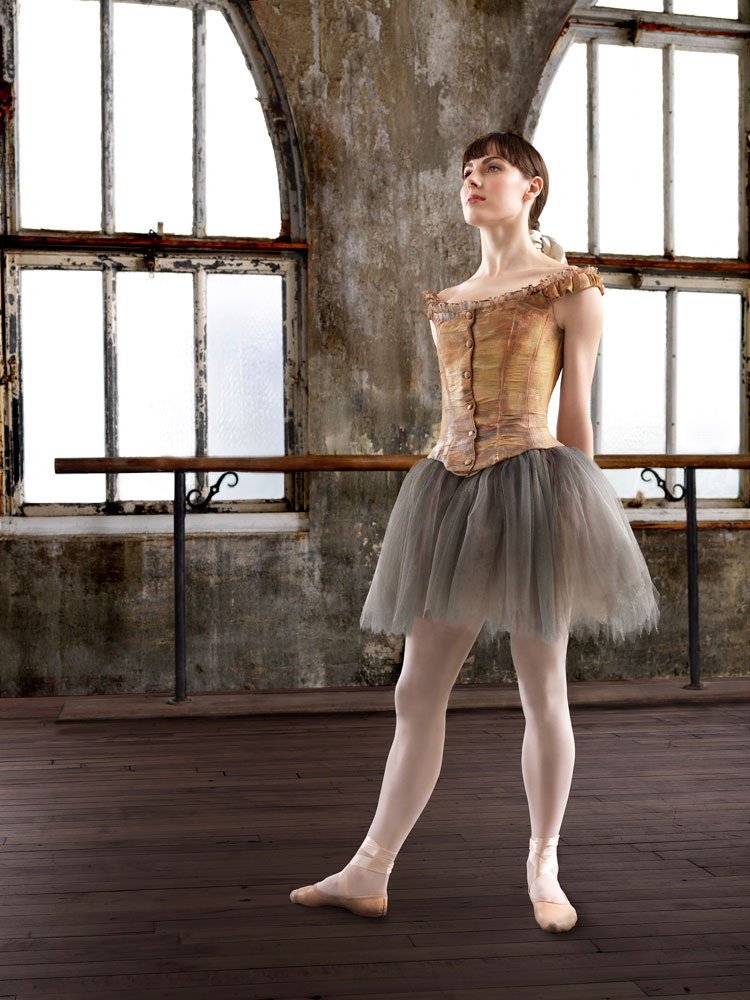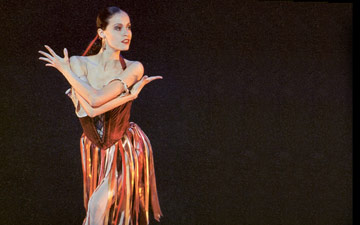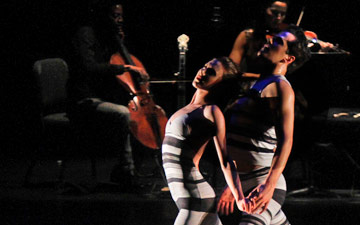
© Oksana Khadarina. (Click image for larger version)
www.nga.gov
Washington exhibition details
Kennedy Center production of Little Dancer
Degas’s Little Dancer
She is known around the word as “Little Dancer Aged Fourteen” – the most celebrated of Edgar Degas’s sculptures and the only sculpture he ever exhibited during his life. This rather small (only 39 inches tall), unassuming statuette of a young dancer, which the artist made of wax, clay, wood and wire and dressed in real ballerina clothes and a wig decorated with a ribbon, has become one of the most famous sculptures of European modern art. It’s widely recognized as Degas’s seminal work and an important precursor to expressionism, cubism and surrealism.
This stoic little girl found her permanent home in Washington D.C. at the National Gallery of Art. She is the talk of the town this month as the star of the recently-opened exhibition, Degas’s Little Dancer, and an inspiration for the brand-new musical Little Dancer presented by the Kennedy Center for the Performing Arts and directed and choreographed by five-time Tony Award winner Susan Stroman. The musical will start preview performances at the Kennedy Center’s Eisenhower Theater on October 25 and run through November 30; and will feature a star-studded cast, including New York City Ballet principal dancer Tiler Peck as young Marie van Goethem, the real-life dancer of the Paris Opera Ballet who was the model for Degas’s legendary sculpture.

© Oksana Khadarina. (Click image for larger version)
The exhibit at the National Gallery of Art is relatively small. It’s a one-pavilion show which, along with the original wax sculpture of Little Dancer, includes a selection of 14 works by Degas in a variety of media – oil paintings, pastels and sculpture – all united by a single subject: ballet.
Edgar Degas (1834-1917) is known as the supreme painter of dance. His fascination with movement turned into a life-long obsession, and dance offered him the perfect opportunity to study the human figure in motion. The unadorned world of ballet as seen from the stage and the foyers, from dressing rooms to the rehearsal studios of the Paris Opera Ballet, was the central theme of his art. Of the nearly 2,000 works he created during his prolific career, more than half were dedicated to dancers and the everyday realities of their difficult craft. With a patient, observant eye, Degas captured the grace and elegance of the dancers as well as their private moments off-stage. In fact, he preferred showing the dancers in less than glamorous moments. In his paintings the young girls are often depicted stretching at the barre, adjusting their stockings and hair, pulling up their bodices, or looking exhausted and jaded. He showed ballet dancers as real human beings rather than beautiful, ethereal creatures.

© Matthew Karas. (Click image for larger version)
When Degas presented Little Dancer at the Sixth Impressionist Exhibition in Paris in 1881, her remarkable realism shocked the public and critics alike. The viewers were almost unanimously appalled by the figure’s sheer unattractiveness. Some called her a repulsive monster, or an anatomical specimen that belonged in a museum of anthropology. Only a few expressed fascination with Little Dancer’s life-like qualities, praising the artist’s “troubling, singular naturalism.” “This statuette is the only true modern attempt I know in sculpture,” wrote one critic.
Today it’s hard to imagine that this sculpture of a young girl who seems to be so poised and relaxed as if lost in her own thoughts could have caused such heated controversy. As she stands with her eyes half closed, her feet firmly placed in balletic fourth position and her hands clasped behind her back, she looks very ordinary – a typical teenager, not a conventional beauty but definitely a very cute girl. More than anything else, with her uninhibited posture and confident appearance, she comes across as the embodiment of youthful spirit. At the time of Little Dancer’s creation, however, the public was not ready for a subject so unconventional in its social status and naturalness.
Fine art sculpture of the time glorified gods, ancient heroes and monarchs. The artists cast their works in marble and bronze to ensure the immortality of their art. But Degas wanted nothing of that sort. His model was the 14-year old Marie Geneviève van Goethem, a young member of the corps of the Paris Opera Ballet. She was the middle daughter of an impoverished family of Belgian origin; her mother was a laundress and her father a tailor. They lived in a poor neighborhood of Paris, as did many of her fellow students, known as “petite rats” of the Opera. The young dancers were easy prey for wealthy men – abonnés – who were season ticket holders of the theater; and many dancers had no other choice than to become sex-workers in order to augment their scanty income and to support their families. Girls like Marie were looked down upon by the elite Parisian society, for whom “ballerina” was synonymous with sexual transgression.
No wonder that for many viewers in late 19th century Paris, Little Dancer was the symbol of poverty and vice. To make the matter worse, Degas chose to exhibit his sculpture alongside his pastel painting, Criminal Physiognomies, which depicted two young men on trial for murder. “Can art descend lower?” wondered one critic.

© Matthew Karas. (Click image for larger version)
Yet Degas’s intent was not to judge but to humanize the subject of his sculpture, neither glamorizing nor sentimentalizing her circumstances. “What is overwhelmingly evident is that, from its inception, Degas chose to engage with one of the most resonant images of his day, an image that was seen by his peers to link high art with the gutter and to provoke anxiety as much as approval… Degas’s audiences were either thrilled by its novelty or exasperated by its awkwardness, while none seemed indifferent to the sculpture’s present,” wrote English art historian Richard Kendall in his book “Degas and the Little Dancer.”
There was no buyer for Little Dancer at the Paris exhibition in 1881; and Degas never exhibited the sculpture again. After the artist’s death in 1917, some 27 bronze replicas of the original wax figure were cast. Many of them made their way to the world’s major museums, contributing to the piece’s global popularity. You can see Little Dancer’s bronze sisters at the Metropolitan Museum of Arts in New York, the Baltimore Museum of Art, the Tate in London and Musée d’Orsay in Paris.
It was during a visit to Musée d’Orsay that Susan Stroman, the director and choreographer of the Kennedy Center’s new musical production, Little Dancer, saw the bronze cast of Degas’s iconic sculpture. She was captivated and inspired by the young girl’s mysterious look, wondering about her life story and final destiny. How did her inspiration materialize? The Washington audience is about to find out.
















You must be logged in to post a comment.